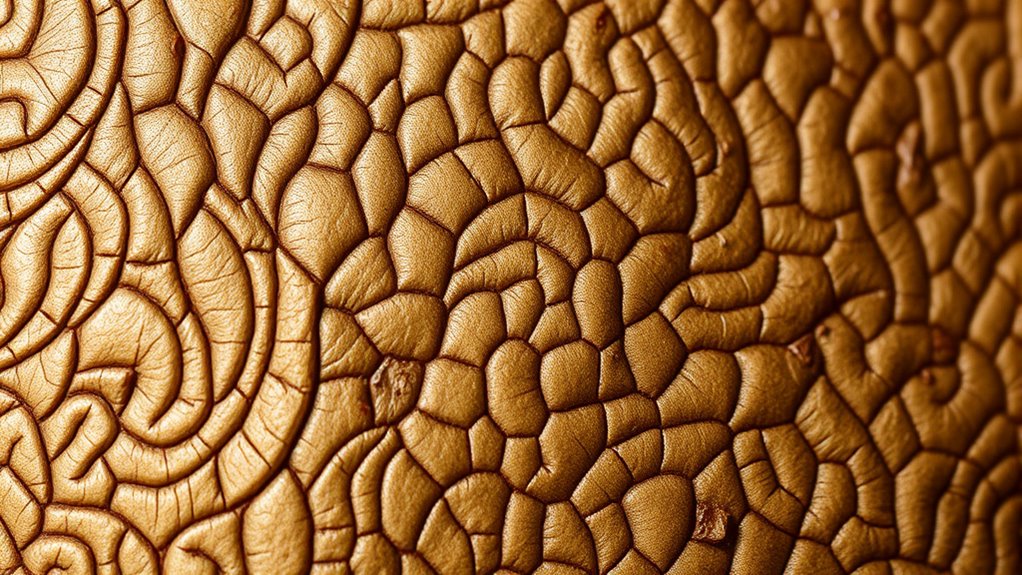Mushroom leather is quickly gaining acceptance as a sustainable, plant-based alternative to traditional leather. As more brands incorporate it into their collections, consumer perceptions are shifting toward valuing eco-friendly and cruelty-free options. Its stylish, versatile appeal makes it a popular choice for handbags, sneakers, and accessories. This cultural shift shows a growing appreciation for environmentally conscious fashion, and if you keep exploring, you’ll discover how these innovations are shaping the future of the industry.
Key Takeaways
- Growing consumer demand for sustainable, ethical fashion fuels acceptance of mushroom leather as a plant-based alternative.
- Brands increasingly incorporate mushroom leather into collections, normalizing it as a stylish, durable, eco-friendly material.
- Cultural shifts toward valuing environmental responsibility enhance the perception of mushroom leather as a luxury, eco-conscious choice.
- Improved texture, color, and versatility of mushroom leather boost its appeal and mainstream acceptance.
- Industry adoption signals a move toward sustainable innovation, fostering broader acceptance of plant-based materials in fashion.

Have you ever wondered if there’s a sustainable alternative to traditional leather? As the fashion industry faces increasing pressure to reduce its environmental footprint, sustainable innovation has become more than just a trend—it’s a necessity. Mushroom leather, made from mycelium or the root-like structures of fungi, is gaining attention as a promising plant-based material that could revolutionize how we think about fashion and sustainability. Unlike conventional leather, which involves resource-intensive processes and ethical concerns, mushroom leather offers a more eco-friendly and innovative solution that aligns with modern values. Its rise in popularity reflects a broader cultural shift towards accepting plant-based materials as viable, stylish, and responsible options for consumers and designers alike.
Mushroom leather offers an eco-friendly, innovative alternative to traditional leather, shaping a sustainable future for fashion.
The acceptance of mushroom leather in the fashion industry isn’t accidental. It’s driven by a genuine desire to find sustainable innovations that meet the aesthetic and functional demands of consumers while minimizing environmental harm. When you consider how traditional leather production involves significant water usage, chemical tanning, and animal cruelty, it’s clear why many are turning to alternatives like mushroom leather. This material can be produced with less water, fewer chemicals, and in a manner that’s more aligned with ethical standards. As more brands incorporate mushroom leather into their collections, it signals a growing cultural acceptance of plant-based materials that challenge traditional notions of luxury and durability. You might notice that these products are becoming more stylish, durable, and accessible, which helps normalize their presence in mainstream fashion.
In addition, the story behind mushroom leather resonates with consumers who are increasingly conscious about their environmental impact. More people want to support brands that prioritize sustainability and innovation. This cultural acceptance isn’t just about trends; it’s about shifting perceptions of what constitutes quality and luxury. As mushroom leather continues to develop in terms of texture, color, and versatility, it’s becoming a symbol of how the fashion industry can adapt to ecological and ethical needs. You’re likely to see it in everything from handbags to sneakers, as designers recognize its potential to blend fashion with sustainability. Furthermore, the growing importance of ethical standards in production is influencing consumer preferences and industry practices alike. The growing popularity of plant-based materials like mushroom leather demonstrates that the industry is evolving, embracing new technologies and ideas that challenge the status quo while still delivering style and function.
Ultimately, the cultural acceptance of mushroom leather signals an exciting future where the fashion industry leads the way in sustainable innovation. It’s a step toward reducing our reliance on animal products and minimizing environmental impact without sacrificing style. As a conscious consumer, you play a crucial role in this shift by choosing products that reflect these values. Mushroom leather embodies the possibility of a more responsible, innovative, and inclusive approach to fashion—one that respects both the planet and its people.
Frequently Asked Questions
How Does Mushroom Leather Compare in Durability to Traditional Leather?
You’ll find that mushroom leather offers a good durability comparison to traditional leather, but it may not be as long-lasting for heavy-duty use. Its wear resistance is improving with advancements in production, making it suitable for fashion items and accessories. However, for rigorous applications, traditional leather still outperforms mushroom leather in durability. Overall, mushroom leather’s growing popularity reflects its eco-friendly appeal and increasing resilience.
Are There Any Health Risks Associated With Wearing Mushroom Leather?
Wearing mushroom leather is generally safe, but don’t forget that allergy concerns exist—some people might react to fungi or chemical residues from processing. While it’s less likely to cause chemical exposure than synthetic materials, always check for any irritants or allergens. Think of it like a new dance—take small steps first to see how your body responds, ensuring you enjoy the eco-friendly style without health risks.
What Are the Environmental Benefits of Mushroom Leather Production?
You’ll find that mushroom leather offers significant environmental benefits, such as promoting sustainable farming and reducing ecological impact. Since it’s made from fungi, it requires less water, land, and energy compared to traditional leather, helping lower greenhouse gas emissions. By choosing mushroom leather, you support eco-friendly practices that preserve natural resources and decrease waste, making it a smart, sustainable option for reducing your environmental footprint.
How Affordable Is Mushroom Leather Compared to Animal-Based Leather?
Mushroom leather is surprisingly affordable compared to animal-based leather, often by a wide margin. When you look at the cost comparison, the production costs for mushroom leather are considerably lower because it requires less resource-intensive processes. This means you can get stylish, eco-friendly items without breaking the bank. As demand grows, expect mushroom leather to become even more budget-friendly, making it a smart choice for conscious consumers.
Can Mushroom Leather Be Recycled or Biodegraded Easily?
You can recycle and biodegrade mushroom leather more easily than traditional leather. The biodegradation process involves microorganisms breaking down the material naturally, making it environmentally friendly. Recycling methods include composting or repurposing it into new products, which reduces waste. Since mushroom leather is plant-based, it decomposes faster in composting systems, helping you lessen your ecological footprint and support sustainable practices.
Conclusion
As you explore mushroom leather, you’ll see it’s more than just a trend—it’s a step toward a sustainable future. Embracing this plant-based material can help you make eco-friendly choices and challenge old habits. Don’t let this opportunity slip through your fingers; it’s a chance to be part of something bigger. By supporting mushroom leather, you’re planting seeds for a greener tomorrow—so jump in and make a difference today.








